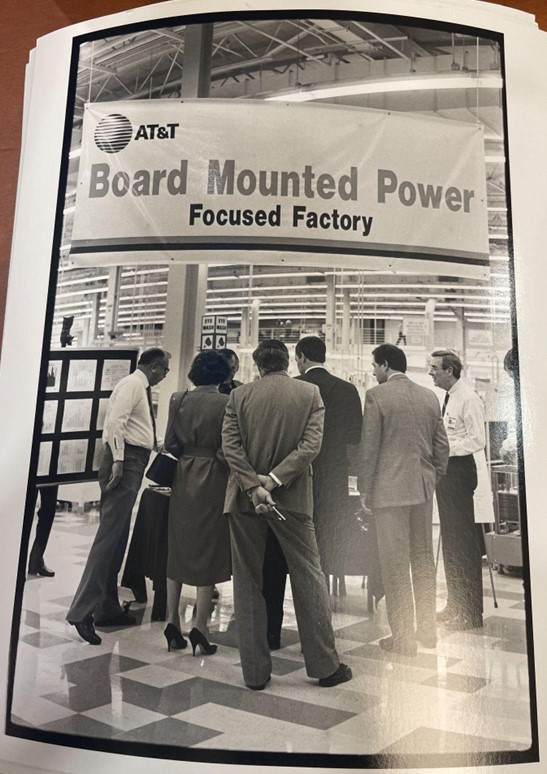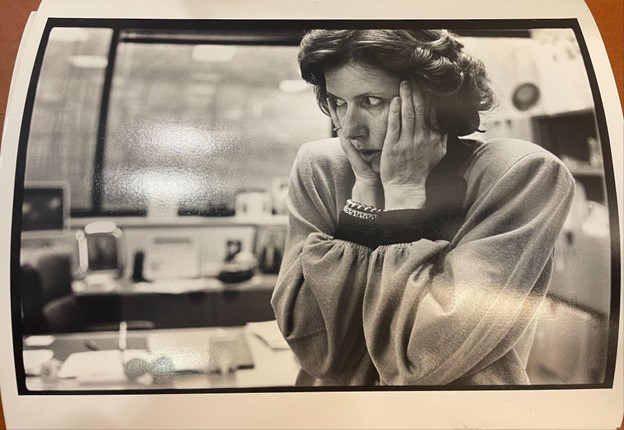By Isabella Pedrera, Journalism ‘26, and Kaylin Pickett, Journalism ‘25, for JOUR 4130 Gender, Race and Class in Journalism and Mass Media with Victoria LaPoe, Fall 2024.
During the fall 2024 semester, the staff of the Mahn Center for Archives and Special Collections worked intensively with Victoria La Poe’s JOUR 4130 class, Gender, Race, and Class in Journalism and Mass Media. The students explored, selected, and researched materials from the collections, then worked in small groups to prepare presentations. The students had the option to then expand their research into a blog post like this one for their final project.
Throughout the semester we were provided with a number of opportunities to explore the archives collection at Ohio University’s Alden Library. These archives provided insight into themes of gender, race, and class and their development throughout history. We chose to focus on the Lynn Johnson Collection, part of the Documentary Photography Archive, with particular emphasis on her photographic contributions to the 1990 Life magazine feature, “The Testing of Dory Yochum.”
Background
Dory Yochum was the middle child of a factory supervisor and a bookkeeper; she was once told by a guidance counselor “that girls could become secretaries, wives or nurses,” (Dowling). She graduated from Pennsylvania’s Wilson College with a degree in history. Then, as a master’s candidate at Rutgers, she applied for a teaching position but was turned down because she was a woman. So, she went to work at AT&T where unequal opportunities worked in her favor.
AT&T was charged with discrimination in 1973 and was ordered to screen for potential women by the court. Yochum was selected for the fast track and sent to an engineering area where the men she worked with attempted to sabotage her. After that, she hopped around to several different positions from manufacturing to human resources. While working in human resources she helped to push through a $10 million benefits program for the care of employees’ children and parents.

Unfortunately, Yochum’s gains at work meant losses at home, like her marriage. As a single mother raising two children, Yochum worked two full-time jobs. Every morning she saw her daughter off to school by 7:25 before leaving for work at 7:45. Her nanny was then in charge of getting her son ready and off to school by 8:10. By that time Yochum was sitting down at her desk to handle memos and meetings that make up her day. Yochum’s husband helped out with the children and watched them when she traveled for work.
Yochum was promoted to chief operating officer of Interconnection Technologies in Microelectronics, a division of AT&T, and although she faced some pushback from her male coworkers, she eventually won them over with her caring managerial style. She became a role model and mentor for many of the men and women who worked under her; one way she embraced this role was by lunching with a few junior female executives. In an interview with Life magazine Yochum said, “There are joys to being in the vanguard. I take great solace in being a mentor to women” (Dowling).
Lynn Johnson Collection Experience: Framing
The article “The Testing of Dory Yochum” published by Life magazine was photographed by Lynn Johnson. Johnson is a photojournalist and alumna of Ohio University, and Alden Library is host to the Lynn Johnson Collection, part of the Documentary Photography Archive, which features over 2 million images. The Dory Yochum photos are a part of that collection. It includes negatives, slides, prints, contact sheets, the article and more information about its publication.

To photograph Yochum’s life, Johnson spent time following her around and capturing moments from her day-to-day life both at work and at home. The story and Johnson’s photos frame Yochum as a confident woman who is leading the way in the destruction of the glass ceiling.
Dory’s Role at AT&T: Community
One of the biggest challenges that Yochum faced during her time at AT&T was fitting in and earning the respect of her male co-workers. From the very beginning of her career at AT&T, she received backlash from the men that she worked with. Beginning after her first promotion they began attempting to sabotage Yochum because they believed that she had stolen it from someone else, specifically a male.
She was at AT&T at the time they were slowly incorporating women into the workplace. “In the seventies, I was one woman in a sea of male faces. You could count on two hands the women at my level in a million employees. Now you’d be as likely to find a woman as a man,” recalled Dowling (Dowling). Due to the lack of women at the beginning of her career, it was hard for Yochum to build a community in the workplace.

Once she became chief operating officer of Interconnection Technologies, she finally found some semblance of a community when she was able to earn the respect of the people that she worked with by proving that she could be a strong and caring leader. She also built a community with the junior female executives that she mentored.
The Glass Ceiling: Intersectionality and Standpoint Theory
The “Glass Ceiling” refers to a metaphorical invisible barrier that prevents minorities from being promoted to managerial and executive-level positions within an industry/business. This phrase is often used to describe the difficulties faced by women and other minorities when trying to advance their positioning in a male-dominated corporate hierarchy. The barriers of the glass ceiling are often subliminal and unwritten, and therefore are fueled by accepted norms and implicit biases rather than defined policy.
Honing into its implications on women, the glass ceiling provides a number of obstacles they must overcome in order to achieve positions like that of Dory Yochum. Yochum was a pioneer of her time and she set a strong precedent for women looking to break into the corporate world, but her journey to the top was not an easy one. Women have a variety of biases to overcome such as being solely care providers, leading with too much emotion, and the presumption of being weaker than men. In a survey of HR professionals, individual contributors and managers, the Society for Human Resource Management (SHRM) found that women were less likely than men to say they’ve received tangible support from managers when attaining higher-level positions.

When considering intersectionality, the barriers of the glass ceiling only become tougher to break. Women of color face even greater difficulties yet, “Female managers of color are over five times more likely than their white female counterparts to say they have quit a job after being overlooked for a new leadership opportunity,” (Gonzales). Being a double-binded minority creates its own challenges in the workplace as women of color become subjected to stereotypes of not only gender but of race as well.
What companies fail to realize is how intersectionality can be used as a tool when put to use within standpoint theory. Standpoint theory suggests that marginalized and oppressed people have a unique perspective that can help create more objective accounts of the world. Two thirds of companies surveyed by the International Labor Organization agreed that diversity initiatives helped improve their business outcomes. The ILO states that when boards are gender-balanced, the predicted probability of achieving increased profitability and productivity is 63%, and the company’s reputation is enhanced by 58%. Therefore, combining intersectionality and standpoint theory and allowing women, particularly women of color, to fill corporate positions would only work as a benefit to companies and enrich the work environment.
The Glass Ceiling in Modern Society: Policy and Solutions
Since Yochum’s achievement of becoming AT&T’s VP of Interim Technology in 1991, the glass ceiling has still posed problems to women striving for higher-level corporate positions. Yochum’s story of hardship, family, and accomplishment was published decades ago, and little has been done since to include women in this male-dominated space. Currently, almost 75% of enterprises worldwide have equal opportunity or diversity and inclusion policies in place, but research conducted by the ILO indicates that these policies alone are not enough to fix the gender imbalance at the top levels of business. Oftentimes, policy alone is not enough because of the subliminal, implicit nature of the glass ceiling.
Solutions to the gender imbalances resulting from the glass ceiling must be greater than policy and work to dismantle the culture and customs of the male-dominated workplace that push women aside. Repairing the system can be done in a number of ways such as promoting work-life balance, ensuring policy buy-in, utilizing the networking abilities of women CEO’s, and challenging societal biases. Ultimately, it is up to businesses to take the initiative to revamp the culture and practices of their workplace in order to achieve gender-balance and foster an inclusive work environment.
References
- Dowling, C. (1990, August). The testing of Dory Yochum. LIFE.
- International Labour Organization. (n.d.). Beyond the glass ceiling. https://webapps.ilo.org/infostories/en-GB/Stories/Employment/beyond-the-glass-ceiling#beyond
- Lynn Johnson collection [finding aid]. Mahn Center for Archives and Special Collections, Ohio University Libraries. https://archivesspace.ohio.edu/repositories/2/resources/508
- MarketScreener. (n.d.). Doreen S. Yochum. https://in.marketscreener.com/insider/DOREEN-S-YOCHUM-A010TL/
- Gonzalez, Matt. Society for Human Resource Management. (n.d.). The glass ceiling: Women and barriers to leadership. https://www.shrm.org/topics-tools/news/inclusion-diversity/glass-ceiling-women-b
- Star-Ledger. (2023). Doreen Yochum obituary. https://obits.nj.com/us/obituaries/starledger/name/doreen-yochum-obituary?id=23982854